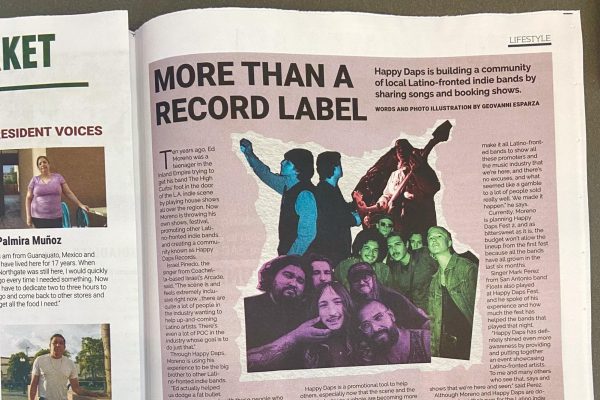“Sports Illustrated” swimsuit edition brings waves of questions
March 3, 2016
For better or for worse, “Sports Illustrated” has made history. For the first time ever, a plus-size model was featured on the cover of their 2016 swimsuit edition. Released in January, this particular edition of this long-standing annual tradition is bringing about questions of just how forward thinking “Sports Illustrated” was in making this editorial decision.
Size 16 model, Ashley Graham, is the first plus-size model to pose for “Sports Illustrated.” She is beautiful, but is she what an everyday plus-sized female looks like?
It seems that her body is perfectly proportioned in her bikini. Although she is a size 16, she looks as if she does not have excess belly fat or thunder thighs. How lucky for her.
Is the new trend of including plus-size people, especially women, in the fashion industry just another way of showing the public another unrealistic standard?
No female body is the same so there should not be an “ideal” body image for women to look up to and it is amazing that our society is now coming around to the idea that not all females look a certain way. This is a trend that has been on the rise as of late and this cover is just the l atest iteration of it.
atest iteration of it.
“Sports Illustrated” is actually late to the party on
this front.
“It’s hard to say what was the motive behind SI’s decision to select a plus-size model for the cover this year,” said Cathy Taylor, Marketing Professor at Elgin Community College. “From all indications, [“Sports Illustrated”] is somewhat late on the movement to be inclusive of all body types for its annual swimsuit issue. Other marketers have launched plus-size campaigns in the past [such as] Dove, Playtex, etc.”
Most females have curves and body fat. This is something the fashion industry struggles with, but this does not mean that the way the plus-size community is currently being represented is all-inclusive
as well.
By no means is it being said that there is an “ideal” plus-size shape. However, even the depictions of this group of people in the media are just another method of showing the public what it should look like.
Graham is full-figured but still looks good in a bikini, so it’s OK to put her on the cover of a men’s magazine.
Kudos to “Sports Illustrated” for the initiative but there is still a long way to go.
First year student, Hannah Cooke, supports the publication’s decision of showcasing a plus-sized model, but it should not matter that she is plus-sized.
“I just feel that it shouldn’t even be a big deal whether a woman or man on a cover is plus-sized or not. It goes back to how society is too dependent on looks,” Cooke said.
From a male’s point of view, it can be misleading. Second year student, Tyler Kruse, has various opinions about having a plus-sized model on the cover.
“It’s a good step forward into people being more accepting of each others differences. Such as weight, religion, political views etc. So it is good in that aspect,” said Kruse. “It could also be a negative shift towards health. America’s obesity rates are getting higher and higher and it’s showing people that it is okay to be fat. Not saying there is anything wrong with it. But generally being fatter causes a lot of health issues, they go hand in hand. The number one killer in America is Heart attacks. So it can go both ways with ‘skinny’ and ‘plus size’ models. One gives people anorexia, and one gives heart attacks.”
Overall, Kruse believes that we should all support a healthy lifestyle no matter what size.
Of course, this brings us back to the point of Graham being plus-sized but not looking unhealthy and actually looking really good in the bathing suits they put her in.
This is the version of plus-sized that the magazine has chosen to represent not only their publication and company, but also say to the public that they are trying to break the mold on the stereotype of the swimsuit model.
Putting an image of what might be considered controversial definitely did what it was supposed to do: it got people talking.
“Clearly [their] readership includes both men and women. Either way, the decision created buzz around the [“Sports Illustrated”] brand. It got people talking and it created engagement with the swimsuit edition,”
said Taylor.
This cover has even come up in some students’ classes.
“I am teaching a gender roles class this semester and the students are very verbal since we have already covered the topic of men and women in the media,” said Sociology Professor Patricia O’Brien.
Selling copies is, of course, a factor in choosing what goes on the cover on a magazine, and this is a great example of that.
Taylor supports the idea that this decision is directed toward increasing sales.
“As a marketer, I highly suspect this was a data-driven decision, meaning that ‘Sports Illustrated’ may have decided to go this route in response to subscriber research that shows readers are open to seeing models that represent the majority of women as opposed to the typical model size,”
said Taylor.
Society might be ready to see other representations of bodies on the cover of magazines and other mediums, but can that ever actually be all-inclusive?
Are we ever going to get to a point where every different type of person is depicted in advertisements and covers of publications people pick up regularly?
We may not ever know the answer to these questions, but Graham has opened the door to having those conversations and starting to change current standards.
She is beautiful woman who deserves recognition and she has gotten it, but there is a long road ahead in terms of accurately depicting such a specific part of society.
Hopefully “Sports Illustrated,” and other publications, continue to make decisions like these so we can combat unrealistic beauty expectations.
Photo Courtesy of sportsillustrated.com




